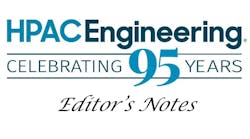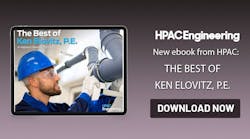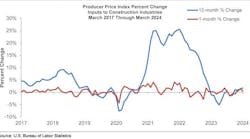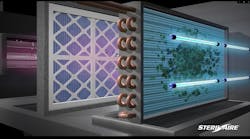Buckle up. The future is knocking on the door to our industry yet again.
Believe it or not, Artificial Intelligence (AI) search tools like ChatGPT may soon become common in engineering practice. These tools use "Large Language Models" to search huge volumes of text. They return quick results based on common word patterns in the database. Therefore, AI search results reflect both content and context. The search algorithms retrain or "learn" based on feedback from user evaluations of AI responses.
While Large Language Models analyze enormous volumes of text quickly, they can also produce irrelevant or even incorrect responses. As a result, they are not a substitute for engineering judgment. Here are some dangers inherent in using AI for engineering research, based on recent searches conducted by the author:
Results might not be up-to-date
A December 2023 inquiry to ChatGPT on "ashrae handbook cooling load calculation method" returned a brief discussion of the CLTD/CLF method. The discussion seemed accurate, but the ChatGPT response also said it was last updated in January 2022 and it included a disclaimer that there might be more recent information.
Indeed, Chapter 18 of the 2021 ASHRAE Handbook - Fundamentals discusses mostly the 'Heat Balance Method' and its derivative 'Radiant Time Series Method'. CLTD/CLF is also mentioned in the last section of that chapter as a valid method, but it is not regarded in the handbook as the current "state of the art." Therefore, ChatGPT's answer was not up-to-date and not fully responsive to the inquiry. So, the risk that search results might not be up to date diminishes the utility of the tool.
Responses do not always address the question
While reading the December 2023 issue of ASHRAE Journal, its article on potential conflicts between two ASHRAE ventilation standards, Standard 62.1 (Ventilation for Acceptable Indoor Air Quality) and Standard 170 (Ventilation of Health Care Facilities), caught my attention.
As a test, I asked ChatGPT about "meeting ASHRAE standards 62 and 170" returned only a brief, general discussion of the scopes of the two standards. It then concluded that "To meet these standards, designers, engineers, and facility managers need to carefully review and implement the specific requirements outlined in ASHRAE 62 and 170." Therefore the response did little more than restate the inquiry. It did not provide the requested guidance on how to meet both standards at the same time.
Responses do not have references or citations
Another article in that same issue of ASHRAE Journal discusses the need for field data to validate ground source heat pump design models.
The particular concern is ground heat exchanger temperature changes over time. The article cites two systems where ground temperatures rose enough over time to interfere with proper cooling system performance. The author identified two factors likely to influence the success of a ground source heat exchanger. The first is the size of ancillary loads like pump and fan heat. The other is the annual balance between heat withdrawal and heat rejection.
With that in mind, I asked ChatGPT for advice on "ground source heat pump temperature rise over time." The response identified some general factors that affect ground heat exchanger performance but did not provide engineering insight or the basis for its assertions. For example:
- ChatGPT reported that seasonal variation in the difference between ground temperature and air temperature affects heat transfer to the ground. That assertion needs substantiation because the heat transfer of interest is from water (or refrigerant) to the ground. Air temperature is not the operative factor and affects water temperature only indirectly as it affects load;
- The response also said "Oversizing or undersizing the system can impact its ability to extract or reject heat efficiently." It did not say which system actually has the concern for over- or under-sizing: the building HVAC system or the ground heat exchanger;
- ChatGPT reported "Over extended periods, there can be slow changes in the ground temperature due to factors like climate change, urbanization, or alterations in land use." However, it did not discuss the direction of ground temperature change (up or down). It also did not mention the annual balance between heating and cooling load, which the ASHRAE Journal article specifically mentions as important.
Without citations, it is hard to know whether the sources that ChatGPT uses are relevant to the situation that prompted the inquiry. Wikipedia has been criticized as not necessarily reliable because almost anyone can contribute to that database. At least most assertions in Wikipedia have references to their source, however.
Of course, A.I. and Large Language Models are new and developing technology. But it is important to remember that they only find, organize, and present content. They do not create content (at least not yet). So A.I. is not really new in terms of using the technology responsibly in professional practice. Indeed, it is easy to substitute "A.I." for "computers" in this quote from 2014:
Computers have significantly reduced repetitive calculation for engineers and provided convenient ways to demonstrate, save, and transfer engineering products. Computers are not time bombs as long as engineers keep in mind that, similar to slide rules and calculators, computers are tools to assist them in solving problems. Computers are not decision makers. [So] engineers always should double-check computer-generated calculations.1
###
1 Wang, Yijun, "The Computer in Engineering: Tool or Time Bomb?" HPAC Engineering, Vol. 86, No. 3, March 2014, also available at hpac.com/print/content/20927517.
######
A longtime member of HPAC Engineering's Editorial Advisory Board, Kenneth M. Elovitz, P.E., Esq., is an engineer (mechanical and electrical) and in-house counsel for Energy Economics, Inc., a consulting engineering firm in Foxboro, MA.









